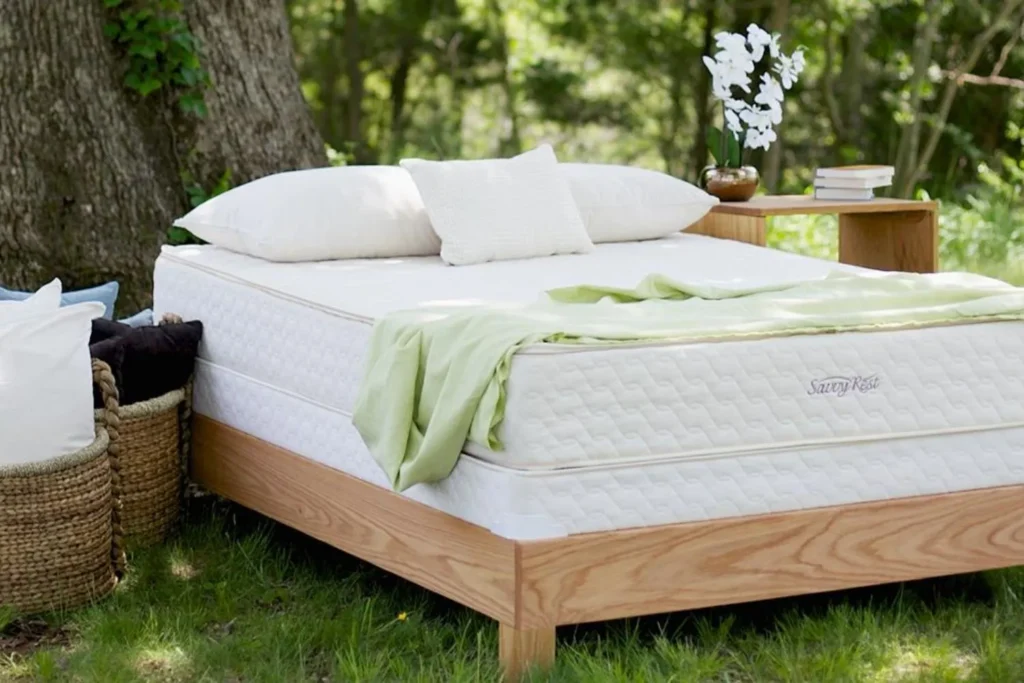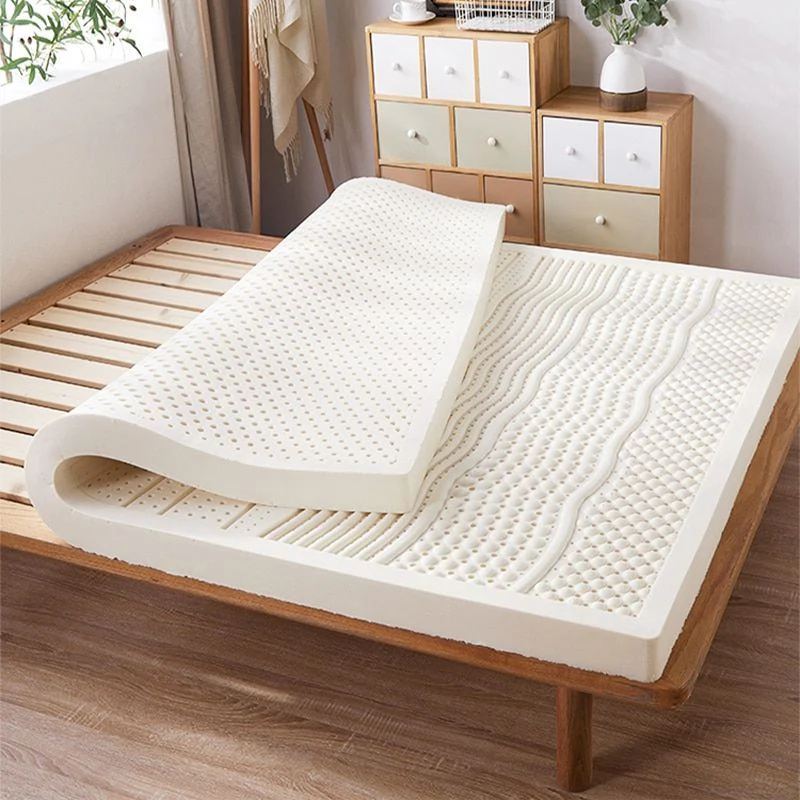Concerns about climate change and environmental impact have led many consumers to reevaluate their purchases—including the items they use every day, like mattresses.
But what makes a mattress “eco-friendly”? Multiple factors, from organic materials to responsible manufacturing practices, contribute to a bed’s environmental footprint.
In this guide, we’ll explore Eco-Friendly Mattress Options, discuss the benefits of going green, and offer tips on finding the best organic mattress that aligns with your values and sleep needs.
Table of Contents
What Makes a Mattress Eco-Friendly?
Definition of an Eco-Friendly Mattress
An eco-friendly mattress is crafted with a focus on sustainability and health. It is made from natural and organic materials, such as organic cotton, natural latex, and wool, which are sustainably sourced and biodegradable.

Using these materials, eco-friendly mattresses minimize the risk of exposure to harmful chemicals, such as flame retardants and volatile organic compounds (VOCs), often found in traditional mattresses.
This reduces the environmental impact and promotes a healthier sleep environment. Choosing an eco-friendly mattress means prioritizing your well-being and the planet’s health.
Importance of Sustainable Sleep Solutions
As awareness of environmental issues grows, so does the demand for sustainable products, including mattresses. Traditional mattresses can contain harmful chemicals that threaten human health and the environment.
For instance, flame retardants and VOCs can contribute to indoor air pollution and have been linked to various health problems. Eco-friendly mattresses offer a sustainable alternative, free from these harmful chemicals.
By opting for a green mattress, you are reducing your environmental footprint and ensuring a healthier sleep environment. Sustainable sleep solutions are an essential step towards a more eco-conscious lifestyle.
Why Choose an Eco-Friendly Mattress?
Health Benefits
Low or No VOCs: Synthetic foams and chemical adhesives can release volatile organic compounds (VOCs), potentially contributing to allergies or respiratory issues. Sustainable mattresses often use low-VOC adhesives or none at all.
Hypoallergenic Materials: Natural fibers like organic cotton or bamboo are less likely to trigger allergies. Organic latex mattresses benefit individuals with allergies due to their naturally hypoallergenic materials, reducing the likelihood of allergens such as dust trapped in the bed.
Environmental Impact
Reduced Carbon Footprint: Sourcing organic or natural materials can reduce carbon emissions from farming and production.
Organic mattresses, in particular, are known for their eco-friendly aspects and often come with certifications that ensure they meet stringent environmental standards.
Biodegradability: Eco-friendly mattresses often use components that break down more easily at the end of their life cycle, reducing landfill waste.
Longer Lifespan
High-Quality Natural Components: Materials such as natural latex tend to be durable and resilient, maintaining shape and support longer than cheaper synthetics.
A latex mattress crafted from organic materials like certified cotton and wool offers exceptional durability and support, promoting better sleep quality and environmental sustainability.
Common Sustainable Mattress Materials

Organic Cotton
Pesticide-Free: Grown without harmful chemicals, helping preserve soil quality and protect worker health.
Breathable & Comfortable: Cotton naturally wicks away moisture, aiding temperature regulation. The quilted organic cotton cover enhances comfort and breathability, making it ideal for hot sleepers.
Organic Wool
- Natural Flame Retardant: Wool’s structure makes it inherently flame-resistant, reducing the need for chemical fire retardants.
- Temperature Regulation: Wool fibers trap air, offering insulation in cooler months and breathability in warmer weather.

Natural Latex
Latex sap is harvested from rubber trees in a process that doesn’t harm the trees, making it a renewable resource.
Highly Durable: With proper care, natural latex can last over a decade, and its elasticity offers excellent pressure relief.
The Avocado Green Mattress is a prime example. It is known for using all-natural materials like organic cotton and wool, multiple eco-certifications, durability, and comfort features, making it a top choice for eco-conscious consumers seeking a nontoxic sleeping environment.
Bamboo
- Rapid Growth: Bamboo is one of the fastest-growing plants, making it highly renewable.
- Anti-Microbial Properties: Bamboo-derived fabrics often resist bacterial growth, keeping bedding fresh longer.
Types of Eco-Friendly Mattresses
Natural Mattresses
Natural mattresses are a cornerstone of eco-friendly sleep solutions made from sustainable and non-toxic materials.
These mattresses often feature organic cotton, natural latex, and wool, which are biodegradable and responsibly sourced.
Natural mattresses are designed to be breathable, enhancing airflow and temperature regulation for a more comfortable sleep. Here are some popular types of natural mattresses:
- Organic Cotton Mattresses: These mattresses are made from GOTS-certified organic cotton, ensuring that the cotton is grown without harmful chemicals. Organic cotton mattresses are soft, breathable, and gentle on the skin, making them an excellent choice for those with sensitive skin or allergies.
- Natural Latex Mattresses: Made from natural latex harvested from rubber trees, these mattresses are supportive, pressure-relieving, and highly durable. Natural latex is a renewable resource, and mattresses from it often come with the Global Organic Latex Standard (GOLS) certification, ensuring they meet high standards for organic content and sustainability.
- Wool Mattresses: Wool is a natural material known for its breathability and temperature-regulating properties. Wool mattresses are hypoallergenic and naturally flame-resistant, reducing the need for chemical fire retardants. They provide a comfortable and safe sleep environment.
Consider certifications such as the GOTS (Global Organic Textile Standard) and the GOLS (Global Organic Latex Standard) when shopping for an eco-friendly mattress.
These certifications ensure that the materials used in the mattress meet rigorous standards for sustainability and environmental responsibility, giving you peace of mind that you are making a responsible choice.
Certifications to Look For
GOTS (Global Organic Textile Standard)
Ensures cotton or wool meets strict organic standards from harvesting to finished product, covering labor and environmental practices.
GOLS (Global Organic Latex Standard)
Specifically, it addresses organic latex, verifying that the product contains a high percentage of certified organic latex and meets certain social and environmental criteria.

OEKO-TEX® Standard 100
Tests for harmful substances in textiles, ensuring the mattress or bedding materials are safe for human use.
Forest Stewardship Council (FSC)
If the mattress incorporates wooden components, the FSC certification ensures the wood is sourced from responsibly managed forests.
Sustainable Manufacturing Practices
Local Sourcing
Reduces transportation emissions.
Supports local economies and ensures better oversight of labor conditions.
Non-Toxic Adhesives
Avoid harmful glues that may off-gas into your living space.
Responsible Waste Management
Manufacturers committed to recycling and reducing production waste have a smaller ecological footprint.
Minimal Packaging
Opt for brands that use biodegradable or recycled packaging materials.
Contact us today and get the best offer!
Tips for Choosing the Right Eco-Friendly Mattress
Determine Your Budget
Sustainable materials can be more expensive upfront but often last longer than conventional mattresses, providing better value over time.
Research Brand Reputation
Read reviews and brand statements about eco-friendly initiatives, labor standards, and supplier transparency.
Evaluate Comfort and Support
An eco-friendly mattress must suit your firmness preferences and sleeping style (side, back, stomach).
A medium-firm mattress offers comfort and support, making it ideal for back sleepers and those who switch positions during the night while benefiting stomach and side sleepers.
Check for Return and Trial Policies
Many reputable brands offer sleep trials, allowing you to test the mattress at home and return it if it’s not the right fit.
Consider Disposal Options
When you’re done with your old mattress, look for recycling programs or donation opportunities to keep it out of the landfill.
Beyond the Mattress: Creating a Sustainable Sleep Environment
Eco-Friendly Bedding: Choose organic cotton or bamboo sheets, pillowcases, and duvet covers.
Natural Pillows: Look for buckwheat hull, latex, or down alternatives that are responsibly sourced.

Bedroom Décor: Furnish with FSC-certified wood furniture, and use low-VOC paints for healthier indoor air quality. When comparing mattress types, memory foam is often discussed alongside organic and hybrid options, with organic alternatives generally providing a cooler sleeping experience.
Conclusion
Choosing an eco-friendly mattress means investing in your health, comfort, and our planet’s future.
From organic materials like cotton and latex to certifications that guarantee ethical production, a green mattress can help reduce your environmental footprint while still delivering the support and luxury you expect.
read more articles: Different Bed Bases: Box Springs, Platforms & More – Eco-Friendly Mattresses: Sustainable Choices for a Better Sleep
How Sinyora Yatak Can Help
At Sinyora Yatak, we’re committed to offering sustainable sleep solutions. Our eco-friendly mattress collection features organic materials, responsible manufacturing, and certified safety standards.
Not sure which mattress is best for you? Contact us or visit our showroom to speak with our sleep experts—they’ll help you find the perfect balance between eco-consciousness and personal comfort.
Frequently Asked Questions (FAQ) About Eco-Friendly Mattresses
What kind of mattress is best for the environment?
The best mattress for the environment is made from natural and organic materials, such as organic cotton, natural latex, and wool. These materials are sustainably sourced, biodegradable, and often come with certifications like GOTS and GOLS, ensuring they meet high environmental standards.
What is the healthiest mattress to sleep on?
A mattress made from organic and natural materials is considered the healthiest option. Organic latex mattresses, for example, are naturally hypoallergenic and free from harmful chemicals, providing a healthier sleep environment.
Why are people no longer buying memory foam mattresses?
Many consumers are moving away from memory foam mattresses due to concerns about the off-gassing of volatile organic compounds (VOCs) and the environmental impact of synthetic materials. Eco-friendly mattresses offer a sustainable and non-toxic alternative.
Is there such a thing as an organic mattress?
Yes, organic mattresses are made from organic cotton, natural latex, and wool and are certified free from synthetic chemicals and pesticides. They are designed to provide a healthier and more sustainable sleep environment.
How do I know if a mattress is truly eco-friendly?
Look for certifications such as GOTS, GOLS, and OEKO-TEX® Standard 100. These certifications ensure the mattress meets stringent environmental and safety standards, confirming its eco-friendly credentials.
Can an eco-friendly mattress provide the same comfort as a traditional mattress?
Absolutely. Eco-friendly mattresses often use high-quality natural materials that offer excellent support and comfort. Many brands also provide trial periods, allowing you to test the mattress to ensure it meets your comfort needs.
How long do eco-friendly mattresses last?
Eco-friendly mattresses, particularly those made from natural latex and organic materials, are known for their durability. With proper care, they can last over a decade and often outlast conventional mattresses.
Are eco-friendly mattresses more expensive?
While eco-friendly mattresses can have a higher upfront cost due to the quality of materials and sustainable practices, they often provide better value over time due to their longevity and health benefits.



